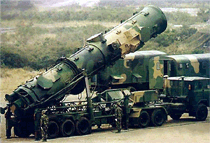|
Washington: The US Pentagon has revealed that China has deployed more advanced, solid-fuel, nuclear-capable CSS-5 medium range ballistic missile (MRBM) against India as a 'deterrent posture'. This model replaces the liquid-fuelled, nuclear-capable CSS-2 intermediate range ballistic missiles (IRBM).  The Pentagon revelation comes in its annual report to the US Congress on the Chinese military build-up. The Pentagon revelation comes in its annual report to the US Congress on the Chinese military build-up.
The report also mentions that Beijing is pumping in huge investments on border infrastructure developments, laying more roads and expanding rail network along the Sino-Indian border. "Although this construction is primarily aimed at facilitating economic development in western China, improved roads could also support PLA border defense operations," it said. The Pentagon report also says that China's close military ties with Pakistan, and its growing footprints in the Indian Ocean, Central Asia and Africa concern New Delhi. On Sino-Indian ties, Pentagon said, that though bilateral dialogue between the two nations increased, border tensions remained an irritant. "China deepened its ties with India through increased trade and high-level dialogues in 2010, though border tensions remained an irritant in the bilateral relationship. Bilateral trade in 2010 reached nearly USD 60 billion," Pentagon said. The two neighbours have held several rounds of dialogue over disputed territorial claims. Sino-Indian defence ties were institutionalised in 2007 with the establishment of an Annual Defense Dialogue, the report said. "Though India cancelled high-level military exchanges following China's denial of visa to a senior Indian general in 2010, both sides agreed to resume exchanges in April 2011," the Pentagon said. The US Defence Department in its assessment said that Chinese prime minister Wen Jiabao's trip to New Delhi in 2010 attempted to smooth over differences following a year of uneasy relations, but he did not address serious irritants. "A high degree of mistrust continues to strain the bilateral relationship," it said. CSS-5 (DF-21)
The CSS-5 is a medium-range, road mobile, solid-propellant ballistic missile, the first such missile system developed by the People's Republic of China (PRC). The CSS-5 represented a shift in the PRC missile programs away from the original liquid-fuelled designs. The CSS-5 is a tactical missile system with strategic applications. It can be effectively used as a deterrent against India, because it lacks the range to reach significant targets, civil or military, in the United States or Russia. With a conventional warhead it can attack targets such as airports, seaports, or key military staging areas. This makes it an effective tactical system. The CSS-5 uses the Transporter-Erector-Launcher (TEL) vehicle launch system which allows it to be easily transportable. Its launch time is only several minutes, allowing it to be deployed during a rapidly changing military situation. Its TEL system allows it to avoid targeting by opposing forces and enables it to be hidden in rough terrain. It is estimated that the CSS-5 can deploy a 600 kg payload with a minimum range of 500 km (311 miles) and a maximum range of 2,150 km (1,336 miles). Its payload carries a single warhead that can be equipped with a 250 or 500 kT yield nuclear device, conventional high explosives, sub-munitions, and chemical agents. It uses an inertial guidance system that is capable of striking with an accuracy of 700m CEP. It has a length of 10.7 m, a diameter of 1.4 m and a launch weight of 14,700 kg. The missile uses a two-stage solid propellant engine. A 2010 report issued by the US Department of Defense noted that 85-95 CSS-5 missiles (of all versions) were probably in operational use.
|